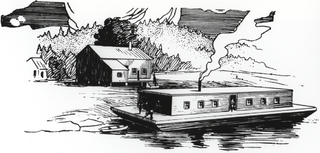Canadian federalism involves the current nature and historical development of the federal system in Canada.
Pith and substance is a legal doctrine in Canadian constitutional interpretation used to determine under which head of power a given piece of legislation falls. The doctrine is primarily used when a law is challenged on the basis that one level of government has encroached upon the exclusive jurisdiction of another level of government.

Reference Re Validity of Section 5(a) of the Dairy Industry Act (1949), also known as the Margarine Reference or as Canadian Federation of Agriculture v Quebec (AG), is a leading ruling of the Supreme Court of Canada, upheld on appeal to the Judicial Committee of the Privy Council, on determining if a law is within the authority of the Parliament of Canada's powers relating to criminal law. In this particular case, the Court found that a regulation made by Parliament was ultra vires. Though the regulation contained sufficient punitive sanctions, the subject matter contained within it was not the kind that served a public purpose.
Section 92(13) of the Constitution Act, 1867, also known as the property and civil rights power, grants the provincial legislatures of Canada the authority to legislate on:
13. Property and Civil Rights in the Province.

Russell v R is a major Privy Council decision regarding the interpretation of the Constitution Act, 1867, and was one of the first cases explaining the nature of the peace, order and good government power in Canadian federalism. It expanded upon the jurisprudence that was previously discussed in Citizen's Insurance Co. v. Parsons.

Ontario (AG) v Canada (AG), also known as the Local Prohibition Case, was a famous Canadian constitutional decision by the Judicial Committee of the Privy Council. It was one of the first cases to enunciate core principles of the federal peace, order and good government power.

Re Board of Commerce Act 1919 and the Combines and Fair Prices Act 1919, commonly known as the Board of Commerce case, is a Canadian constitutional decision of the Judicial Committee of the Privy Council in which the "emergency doctrine" under the federal power of peace, order and good government was first created.

General Motors of Canada Ltd v City National Leasing is a leading Supreme Court of Canada decision on the scope of the Trade and Commerce power of the Constitution Act, 1867 as well as the interpretation of the Ancillary doctrine.

Fort Frances Pulp and Paper v Manitoba Free Press is a famous decision on the Canadian Constitution by the Judicial Committee of the Privy Council on the "emergency doctrine" of the peace, order and good government power in the British North America Act, 1867.

Toronto Electric Commissioners v Snider is a Canadian constitutional decision of the Judicial Committee of the Privy Council where the Council struck down the federal Industrial Disputes Investigation Act, precursor to the Canada Labour Code. The Court identified matters in relation to labour to be within the exclusive competence of the province in the property and civil rights power under section 92(13) of the Constitution Act, 1867. This decision is considered one of the high-water marks of the Council's interpretation of the Constitution in favour of the provinces.

Reference Re Alberta Statutes, also known as the Alberta Press case and the Alberta Press Act Reference, is a landmark reference of the Supreme Court of Canada where several provincial laws, including one restricting the press, were struck down and the existence of an implied bill of rights protecting civil liberties such as a free press was first proposed.

Reference Re Persons of Japanese Race is a famous decision of the Judicial Committee of the Privy Council, which upheld a Supreme Court of Canada ruling declaring a government order to deport Canadian citizens of Japanese descent to be valid.

R v Eastern Terminal Elevator Co is an early constitutional decision of the Supreme Court of Canada on the Constitution's Trade and Commerce power.

The Combines Investigation Act, 1923, was a Canadian Act of Parliament that regulated certain anti-competitive corporate business practices. It prohibited monopolies, misleading advertising, bid-rigging, price fixing, and other means of limiting competition.
Section 91(27) of the Constitution Act, 1867, also known as the criminal law power, grants the Parliament of Canada the authority to legislate on:
27. The Criminal Law, except the Constitution of Courts of Criminal Jurisdiction, but including the Procedure in Criminal Matters.
Section 91(2) of the Constitution Act, 1867, also known as the trade and commerce power, grants the Parliament of Canada the authority to legislate on:
2. The Regulation of Trade and Commerce.

British Coal Corp v R is a decision of the Judicial Committee of the Privy Council in which the authority of the Canadian Parliament to prohibit appeals to the JCPC in criminal cases was upheld.

Canada (AG) v British Columbia (AG), also known as the Reference as to constitutional validity of certain sections of The Fisheries Act, 1914 and the Fish Canneries Reference, is a significant decision of the Judicial Committee of the Privy Council in determining the boundaries of federal and provincial jurisdiction in Canada. It is also significant, in that it represented a major victory in the fight against discrimination aimed at Japanese Canadians, which was especially prevalent in British Columbia in the early part of the 20th century.

Reference Re Companies' Creditors Arrangement Act is a decision of the Supreme Court of Canada on the constitutionality of the Companies' Creditors Arrangement Act as part of the bankruptcy and insolvency jurisdiction of the Parliament of Canada.

Canada (AG) v Ontario (AG)[1937] UKPC 6, [1937] A.C. 326, also known as the Labour Conventions Reference, is a landmark decision of the Judicial Committee of the Privy Council concerning the distinct nature of federal and provincial jurisdiction in Canadian federalism.






